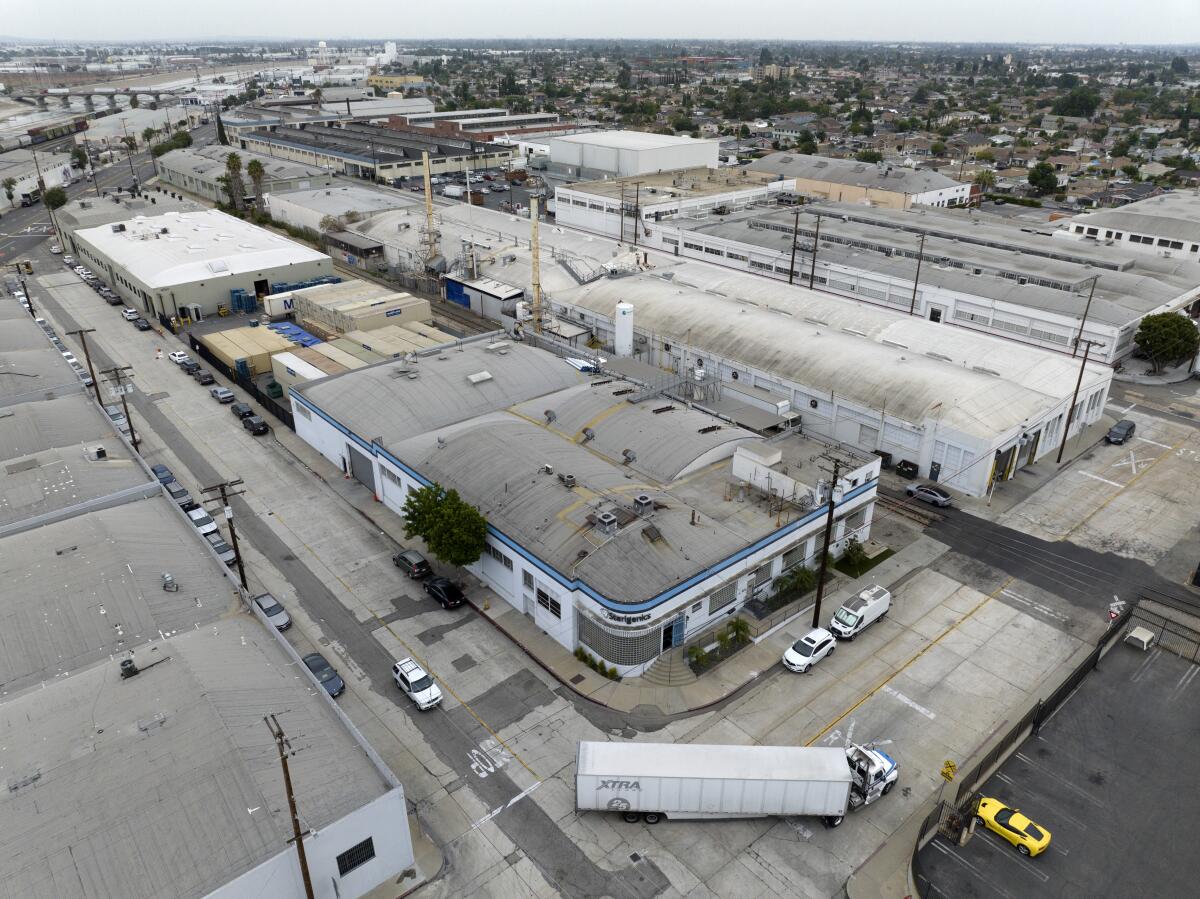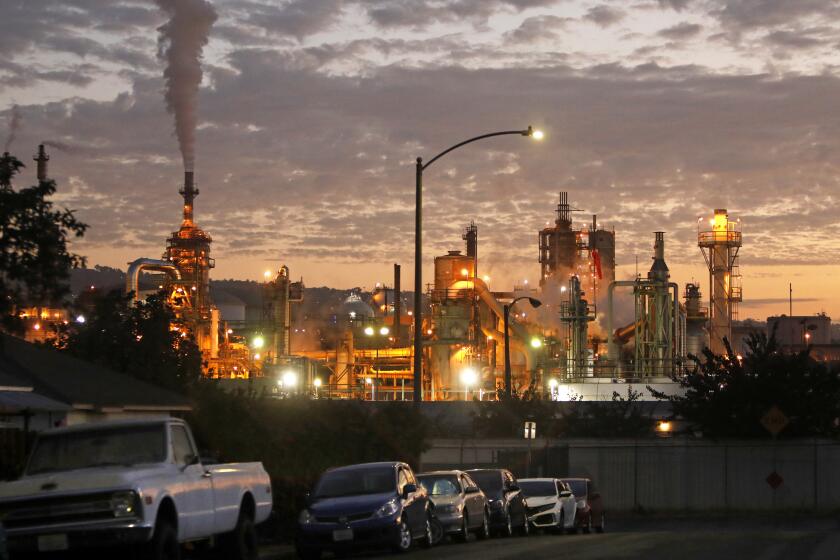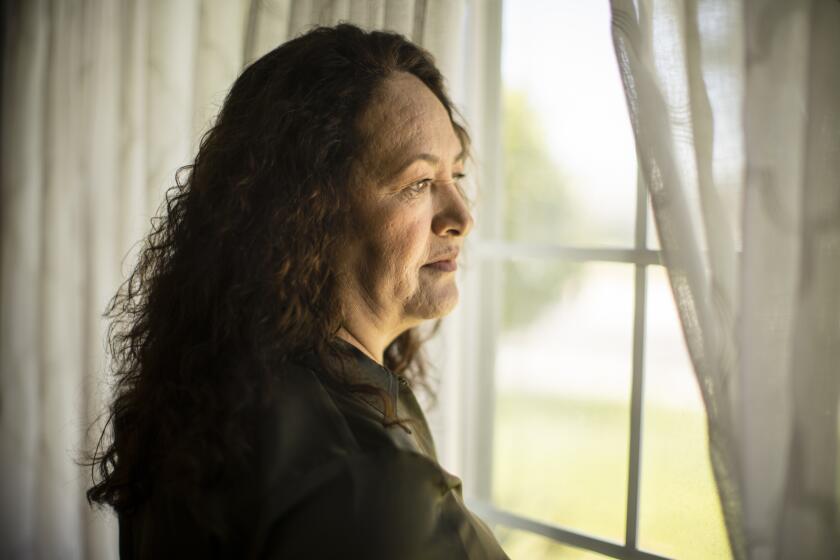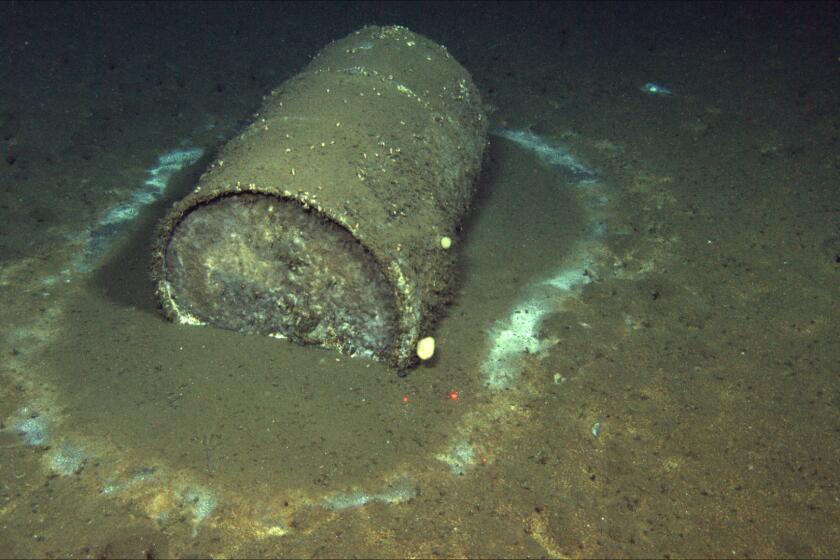Medical sterilizing facilities face growing scrutiny due to toxic gas concerns

- Share via
Southern California air regulators are investigating several facilities that sterilize medical equipment with a carcinogenic gas after preliminary monitoring confirmed their emissions may pose an elevated cancer risk to people who work nearby.
After months of screening for chemical emissions near large commercial sterilizers in Los Angeles and San Bernardino counties, the South Coast Air Quality Management District has issued several violation notices for improperly handling ethylene oxide (EtO), a colorless and odorless gas used to sterilize 50% of the country’s medical supplies.
“Ethylene oxide is an exceptionally good compound at sterilizing these kinds of equipment,” said Dr. Cyrus Rangan, director of the Bureau of Toxicology and Environmental Assessment at the Los Angeles County Department of Public Health. “The downside of it is that ethylene oxide is also a pretty powerful chemical. It’s got some carcinogenic properties. It’s one of a handful of chemicals where there’s pretty good evidence of a link to human cancer with prolonged exposure.”
The violation notices were issued to Parter Medical Products, in Carson, and two facilities run by Sterigenics in Vernon and Ontario.
The actions come as the U.S. Environmental Protection Agency reevaluates the potential toxicity and regulation of ethylene oxide, which epidemiological studies say is a much more potent carcinogen than once thought. The agency describes the chemical as a known carcinogen that increases the long-term risk of developing leukemia, lymphoma and breast cancer when inhaled over a period of years.
California is embracing carbon capture and storage technology to fight global warming, but critics say it will only increase oil production.
In response to the EPA’s growing concern with ethylene oxide, Southern California air regulators have stepped up their monitoring of sterilizing facilities as well. They are also considering amending their rules for sterilizers, including mandates for additional pollution control measures and fence-line monitoring.
The recent notices of violation were issued after testing revealed that concentrations of EtO were many times higher than the state’s “significant” cancer risk threshold for people who work near these sites. The California Division of Occupational Safety and Health, or Cal/OSHA, is also investigating possible workplace health risks within the Vernon facility, which sterilizes more than 45 million essential medical devices and other items every year.
So far, preliminary monitoring has determined the concentrations are much lower farther away from the Sterigenics facilities and do not appear to pose an elevated risk to residential areas or schools in Vernon or Ontario. However, the air district is in the process of expanding monitoring in Carson to establish if there may be exposure outside of the Parter sterilizing facility, which is about 700 feet from the nearest homes and 2,000 feet from an elementary school.
In a prepared statement, Sterigenics said it was “confident in the continued safety of our employees and the surrounding communities near our Vernon and Ontario facilities. Sterigenics has been fully cooperating with SCAQMD and has addressed the alleged SCAQMD violations at each facility.”
Parter has not yet responded to multiple requests for comment.
California has reached a settlement with the federal government to halt new oil and gas leases on public lands in Central California.
The use of ethylene oxide as a sterilizing agent has grown in recent years as hospitals look to reduce the risk of introducing infections with medical implants while also meeting the drastically higher demand for medical equipment during the COVID-19 pandemic. Although heat, steam and radiation can be used to sterilize objects, some medical devices can only be safely treated using ethylene oxide.
Facilities that use the gas typically have sealed chambers where medical supplies are disinfected and operators are required to capture the vast majority of emissions. Afterward, the treated medical equipment is moved to aeration rooms where remnants of the gas are allowed to dissipate over a period of hours before shipping.
Regulators believe that when they detect high concentrations of the gas at facilities, it’s evidence of so-called fugitive emissions escaping aeration rooms. Emissions may also come from medical supplies as they are loaded onto trucks.
In the South Coast air basin — which includes L.A., Orange and Riverside counties and a portion of San Bernardino County — there are 15 permitted facilities that actively handle ethylene oxide.
The air district has begun screening six facilities that handle more than 4,000 pounds of ethylene oxide a year, but local environmental organizations are demanding more oversight. They say fence-line monitoring should be mandated for EtO, a gas that’s virtually impossible to detect without expensive equipment.
“If a diesel truck goes by, you can smell it. With a sterilizer, you see nothing, you smell nothing,” said Jane Williams, executive director of California Communities Against Toxics. “You have no idea what’s going on and you could be being exposed to massive amounts of it.”
As San Joaquin Valley growers set fire to uprooted vineyards and orchards amid the worsening drought, residents complain of increased air pollution.
At the Parter facility in Carson, between July 10-25, air quality monitors detected average ethylene oxide levels of 81.8 parts per billion — about 25 times higher than what the air district defines as a significant health risk to nearby workers. The district issued a notice of violation July 29 for discharging large quantities that endanger public health.
Consistent exposure to concentrations of just 3.18 parts per billion is considered a “significant” cancer risk for workers over the course of 25 years. Those conditions present the risk of one additional case of cancer per 10,000 workers, according to the Office of Environmental Health Hazard Assessment.
The air district now plans to erect new air monitors at nearby Hemingway Park, Ambler Avenue Elementary and residential areas. For a city that has long struggled with a variety of air quality nuisances — including acrid odors from refineries and the putrid stench of decaying bacteria in the Dominguez Channel — the prospect of additional air testing was greeted warmly.
“These monitoring systems were long overdue,” Carson Mayor Lula Davis-Holmes said.
Barrels of DDT waste — along with other chemicals — were likely poured directly into the ocean near Catalina Island, according to federal regulators.
The other company that was found to be releasing elevated emissions, Sterigenics, has had a history of regulatory issues in other parts of the nation. In suburban Chicago, one of its facilities was shut down due to elevated levels of ethylene oxide.
In unannounced inspections at its Vernon facility, between April 22 and July 2, the average concentration was found to be 21.5 parts per billion — about six times higher than the risk standard for people working nearby.
The air district issued an abatement order after learning five to 40 people who work adjacent to the facility could be exposed to these elevated emissions, according to the air district’s public records.
To satisfy the order, Sterigenics has agreed to install temporary enclosures around its aeration rooms, routinely check for breaches and increase its aeration time at least 24 hours.
Although the air district says it is working with Sterigenics to lower emissions, L.A. County Supervisor Janice Hahn called for the Vernon facility to cease operations.
From June 16-24, the Sterigenics facility in Ontario had average concentrations of 63.6 parts per billion. The facility is in an industrial park with a number of other businesses. However, it is more than a mile away from residential areas and schools.
The air district issued violations alleging the company failed to maintain its equipment in good condition and did not report equipment breakdowns in a timely manner.
Sterigenics has insisted that its operations are safe.
“SCAQMD’s review has indicated the Vernon facilities are not a risk to nearby residents, and SCAQMD’s review of Ontario likewise has not suggested residential concerns,” read a company statement. “We are committed to continuing our record of longstanding compliance with regulatory requirements and safely fulfilling our critical role in safeguarding public health through the sterilization of tens of millions of essential medical devices and supplies at our Southern California EO facilities each year.”
Federal regulators, however, continue to acknowledge an outsized cancer risk from sterilizers, which could see greater enforcement nationally.
EPA Administrator Michael Regan has vowed to propose a federal air pollution regulation by the end of the year that would address the EtO emissions from commercial sterilizers.
The Food and Drug Administration is also exploring potential alternative sterilizing methods.
Environmental organizers, like Williams, understand there are medical devices, such as a heart valve, that may need to be treated with EtO to prevent infections. But the unsafe concentrations of EtO in Southern California should motivate regulators to minimize its use, where possible.
“The vast majority of the stuff being sterilized with EtO could be sterilized with something much less toxic, and that needs to become part of the conversation now.”











